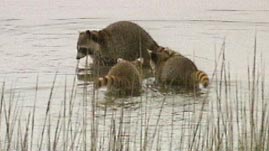Teachers' Domain - Digital Media for the Classroom and Professional Development
User: Preview

Source: Texas Parks and Wildlife Department
In this video segment adapted from Texas Parks and Wildlife Department, learn about the value of the wetlands ecosystems. Wetlands are essential habitats for plants and wildlife and a critical part of the water cycle. Yet they are under threat, largely due to the needs of a growing human population. The video suggests that humans must find a way to balance their needs while protecting and restoring wetlands.
Transitional areas between permanently flooded and dry lands are called wetlands. Wetlands, which include marshes, swamps, and bogs, are found inland as well as along coastlines. Some contain fresh water, others salt water. Land plants do not survive in wetlands: most of the soil is saturated with water during the growing season, and the moisture in the soil squeezes out oxygen that the roots of the land plants require. However, water-loving plant varieties thrive.
Wetlands form in various ways: rain and runoff saturate a low-lying area, groundwater very close to the surface bubbles up through the soil, and periodic floodwaters spread out from rivers and lakes. Animals and humans also play a role in wetlands formation. For example, beaver dams cause rivers and streams to flood surrounding land areas, and fish and wildlife agencies use controlled floods to make areas more hospitable for waterfowl and other wetlands-dependent species.
Wetlands are important ecosystems. Their abundant vegetation and undisturbed stretches make their ecosystems ideal nursing grounds for aquatic animals, including fish and crabs. They serve as winter stopovers for migratory birds, including herons and eagles. They protect property and cleanse the water supply for humans, slowing floodwaters, buffering land from ocean storm waves, and forming natural freshwater reservoirs. And because hunting, fishing, and bird watching remain popular activities, they offer economic and recreational opportunities.
Despite their importance, wetlands have been under serious threat from humans. To support agriculture, development, and shipping, for example, they have been drained and filled in with soil, and the rivers and streams near them have been straightened. This "channelization" increases flow velocity—changing water chemistry and temperature, stripping streamside vegetation, and thereby altering the kinds of life supported by wetlands. Additionally, pollutants from industrial sources have killed vegetation and contaminated water supplies.
Wetlands restoration seeks to re-establish ecological integrity as well as natural structure and function to pre-disturbance conditions. It is a complex process that requires planning, implementation, monitoring, and management. Water level and flow patterns, nutrient cycles, and erosion and sediment deposition must function properly. Plant and animal communities should exhibit diversity and be native to the region. And man-made structures must be removed and waterways permitted to flow as they once did. For a restoration program to achieve its goal, it must address the entire watershed, or surrounding area, and not only a body of water that has been directly affected.
 Loading Standards
Loading Standards Teachers' Domain is proud to be a Pathways portal to the National Science Digital Library.
Teachers' Domain is proud to be a Pathways portal to the National Science Digital Library.
